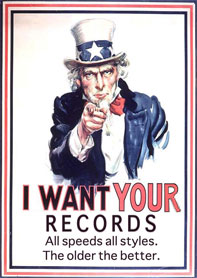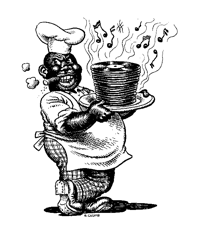[yourchannel user=”Amuse Her” playlist=”PL1yJk3eGuxoLOKlzAHjEeiXYplKrphb4X”]
Glenn Allen Howard – Introduction
Ben Bernie with Jack Pettis Tenor Sax – Sweet Georgia Brown (1925)
Curtis Mosby’s Blue Blowers with Nina Mae McKinney – Swanee Shuffle (1929)
Curtis Mosby’s Blue Blowers with Teresa Harris – Daddy Won’t You Please Come Home? (1929)
Eddie Lang and Joe Venuti (1930)
Sidney Bechet and His New Yorkers (Berlin, 1930)
Duke Ellington – Old Man Blues (1930)
Paul Whitman’s Orch – Happy Feet (1930)
Duke Ellington Concert (1933)
Jimmie Lunceford with Willie Smith, The Three Brown Jacks & Myra Johnson (1936)
Raymond Scott Quintette – Powerhouse
Raymond Scott Quintette – War Dance of Wooden Indians
-
I’ve always called this little combo tune “Art Deco Jazz” because ’tis. Instead of the Satchmo-inspired swing groove that had taken over the world by 1937, this groove is strictly for the robotniks, a few serious squares and the terminally whitebreaded. Still, it has a great mechanical groove and one that Devo would pick up on when new wave was still new, which was a long, long time ago. The Black and Silver Brunswick was one of the first 78s I turned up as a young collector and centuries later I still play the original Master first issue when I need to have my hat spun.
Fortunately, Raymond Scott took a break from his day job – the terminally tedious “Your Hit Parade” to lay down one of the kindest kinoscopes ever krafted – his own Quintette playing his most filling masterpiece of a platter pie, “Powerhouse. “
A big hit on radio and TV since the late ’30s, “Your Hit Parade” pretty much established the top ten as a concept to sell the public and it was just about to become irrelevant. The formula was to have a staff of professional singers covering the hits of the day. At one time, Sinatra was on board, and that helped, but by 1955, rock ‘n’ roll was starting to rear its ugly head. The singing of snotty little cookies like Snooky Lanson was not going to make it when covering the likes of Little Richard and Chuck Berry in a way that could be convincing to anyone to the left of Pat Boone’s right pinkie. The lines had been drawn, and now it was the record that was the hit, not the song. Breaking with the whole history of popular music, the performance of a song was about to be king.
Note the minimalist psychedelic black and white “light show” which follows the horns, an easy decade and a decimal before the Fillmore and Avalon Ballrooms about to run rampant with this art form. It’s not like there weren’t people dosing in 1955. Huxley was about to publish “The Doors of Perception,” it was legal and ramping its way up to really, really rabidly rampant in psychiatric circles especially in and around Southern California. Maybe this suggests usage by the highly stressed, high-pressure, always on a deadline world of the TV industry. They were pretty much all under analysis by then.
Everyone knows this tune from old Warner Brothers cartoons where it was used over and over again, especially by Carl Stalling, who most certainly did NOT write it. It is likely you have never heard the whole piece, let alone watched it being played by the composer’s cool and crazy little combination.
Raymond Scott Quintette – Twilight in Turkey (1937)
Tiny Grimes – One Is Never Too Old To Swing
Duke Ellington – It Don’t Mean a Thing w/ Ray Nance on far too much Sex & Violins in this movie (1943)
Mary Osborne
Mary Osborne – I Surrender, Dear (1958)
Mary Osborne Trip – Blues in Mary’s Flat (1946) audio only
Mary Osborne Trip – Oops, My Lady (1946) audio only
Jazz Party – Coleman Hawkins, Tyree Glenn, Mary Osborne, Hank D’Amico, Teddy Charles, etc. (1929)
Art Tatum – Yesterdays
Bud Powell – I’ll Remember April (1960)
Dave Brubeck Quartet – Take Five
Stuff Smith
Benny Goodman Orch. & Quartet (1937)
Duke Ellington & His Cotton Club Orchestra – Old Man Blues (1930)
International Sweethearts of Rhythm (1946)
-
More women in
Slam Stewart, Big Sid Catlett, Gene Krupa, The Harlemaniacs, Deek
Watson and the Brown Dots – music from ‘Boy What a Girl’ (1947)





